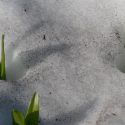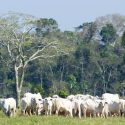Researchers examine role of soil patterns in dam restoration
Looking at the site today, it’s easy to forget that a dam and pond stood for 43 years on the University of Wisconsin–Madison’s Franbrook Farm Research Station in southwestern Wisconsin. All traces of the structure are gone, and acres of plants, both native and weedy, now carpet the floor of the former basin.
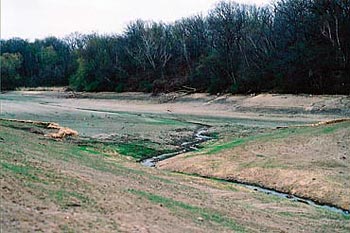
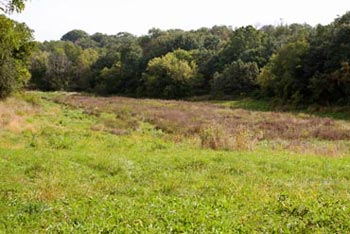
The former basin of the Beers Dam on the UW–Madison Franbrook Farm Research Station in Green County, Wisconsin, is pictured at top three months after the dam was removed in Jan. 2003 by the Wisconsin Department of Natural Resources and above five years later in September 2008. Since 2004, landscape architecture professor John Harrington, soil science professor Nick Balster and soil science doctoral student Ana Wells have been examining the soils in the former basin and their effect on the interaction between restored prairie vegetation and invasive species. The dam was built in 1960 on a spring-fed tributary of Dougherty Creek.
Photos: top, courtesy of Nick Balster; bottom, Wolfgang Hoffman
Nevertheless, memories of the dam remain, and by digging into the soils of the basin, UW–Madison researchers are now unearthing them. Writing in a special issue (December) of Restoration Ecology, they report the discovery of two superimposed patterns of soil properties that chronicle distinct stages in the basin’s history: its decades of submersion, and its emptying when the dam was breached and removed.
“In our analysis, we were able to pick up those different soil patterns, which was pretty exciting,” says soil science professor Nick Balster, who led the study with doctoral candidate Ana Wells and landscape architecture professor John Harrington. “We could see the chemical and physical patterns that were created both by the inundation (of the land) and by the draining.”
Fascinating as those traces of the past are, however, what they mean for the future is the real question, Balster says. After seeding the basin with prairie species, the scientists are now waiting to see if the soil patterns affect the growth and distribution of the plants, and their ability to stand up against weedy, invasive competitors.
“By doing this research, we’re asking the question, ‘How much do soils matter in the restoration of these basins?'” Balster says. “As people who love to study soil we’re going to say, ‘A lot! Soils likely drive the whole thing.’ But as scientists, we don’t know yet.”
Answering that question is becoming more and more pressing. During the past three decades, hundreds of dams nationwide have reached the end of their lives, forcing dam owners to make costly repairs or — increasingly — to remove the structures. With some 3,800 dams to its name — or as many as 10,000, if small, unregulated structures are counted — Wisconsin leads the nation in total dams and has pulled more than 130. States such as California, Pennsylvania and Tennessee have taken out scores of dams as well.
The trend toward removal rather than repair has been driven in part by anglers and river enthusiasts, who justifiably welcome the return the free-flowing rivers and cold-water streams. But the outcome for the once-flooded lands is less certain. Many reports suggest they become havens for aggressive, invading plants such as reed canary grass, which has already consumed hundreds of thousands of acres in Wisconsin and other states.
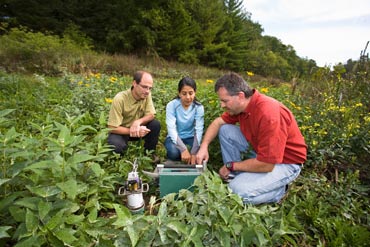
Landscape architecture professor John Harrington (left), soil science doctoral student Ana Wells (center) and soil science professor Nick Balster (right) measure soil respiration in the former basin of the Beers Dam.
The researchers’ work at Franbrook Farm, where the Beers Dam was removed in 2003, has now begun to yield some intriguing clues as to why this might be. For one, the scientists found fundamental differences in nutrient levels and physical structure between the knee-deep sediments that were deposited over the dam’s lifetime and the original soils buried beneath. Most striking, they say, is how uniform the spatial composition of the sediments is when compared to the patchy structure of buried soils. And this lack of chemical and physical variability might be one reason why weeds tend to thrive.
“Because you don’t have the patterns of heterogeneity that allow diverse plant communities to establish, invasive species can come in and move quickly through the area,” says Harrington.
At the same time, the sediments also contained definite gradients in density, moisture and other factors, which were laid down when the dam was breached. Finer sediments, for instance, were picked up by the rushing waters and carried closer to the spot where the dam once stood, while heavier, coarser particles tended to move less and settle farther out.
These gradients in particle size also dictate how some nutrients are distributed on the landscape, says Balster. For example, the team found higher concentrations of phosphorus, which binds preferentially to fine particles, closer to the dam’s former location than farther away.
The scientists’ next goal is to figure out what all this means for their prairie restoration — which isn’t to say they’re rooting necessarily for the native plants.
“If we wanted to, with the expertise on our team, we could likely achieve a restoration of this site, by, say, removing the sediments,” says Balster. “But we’re interested in studying the drivers for restoration. We want to understand the process both above and below ground.”
The research was supported by the Franbrook Farm Foundation in cooperation with the UW–Madison College of Agricultural and Life Sciences and the state of Wisconsin’s Non-Point Source Pollution Project.

